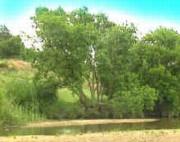

Common Names:
Vaderlandswilg (Afrikaans), Hiccup Nut
Genus: Combretum
Species: erythrophyllum

The Combretum erythrophyllum, or river bushwillow, is a member of the Combretaceae family. This family comprises 20 genus and 500 species, tropical and warm, especially African trees and shrubs. Other names for the river bushwillow include vaderlandswilg and hiccup nut. The reason for the name "hiccup nut" is because the seed, if eaten, will cause violent hiccups.
This plant can be found in the African Savanna at 5 degrees to 15 degrees North latitude and 15 degrees to 50 degrees East longitude. Countries that lie in this biome are Madagascar, Senegal, Guinea, Upper Volta, Ivory Coast, Ghana, Nigeria, Cameroon and Ethiopia.
The African savanna, where the river bushwillow is native, is a rolling grassland with few trees. There are only two seasons, winter and summer, on the savanna. The average temperature in winter is 68 degrees to 78 degrees Fahrenheit. During the summer it is 78 degrees to 86 degrees Fahrenheit. The annual precipitation of 10-30 inches falls during the summer. The river bushwillow prefers full sun and grows along riverbanks. The river bushwillow likes a warm and dry climate. It is 30-35 ft tall with a dense spreading crown. The branches grow rapidly and at crazy angles with an upright manner of growth. The shape of the leaf is a kind of elliptic form, growing on opposite sides of the stem. The leaves are three inches long and one inch wide. The young leaves are pale green, later becoming dark green above and lighter beneath. In early autumn, the color of the leaves is yellow changing to red in mid-winter. The margins are smooth. The leaf base often has two gland-containing flask-shaped cavities at the base. Flowers of the river bushwillow are dense spherical spikes and are 0.4 inches in diameter. The flowers are cream or pale yellow and grow on the tips of the branches just past the new leaves. The fruit is poisonous; causing severe hiccups and is called the Samara. The taproots are long. This is because it is hydrophilic (needing a lot of water to grow). It is easily grown from seed but it is hard to find seeds without parasites.
The river bushwillow has made adaptations that include a hydrophilic root system, thick bark to resist forest fires and leaf drop during dry periods to conserve energy and water. Leaf drop during dry periods is called "drought deciduous" and is an adaptation of plants that grow in dry climates. The river bushwillow is very plentiful with a widespread distribution. It is not endangered because it can survive the cold winters of below 32 degrees Fahrenheit, is fast growing, highly adaptable and grows near rivers where it gets plenty of what it needs (water/sun). It is used for medicinal purposes, commercial wood (carved household utensils) and as a tropical/glasshouse ornamental.
Interesting facts about this plant are:
Its adaptability, fast-growing habit, dense spreading crown, interesting fruit and attractive foliage make it a popular ornamental shade tree.
by Phebe Bates, 2003
Bibliography:
"AFRICANTREES.COM : Tree Details" Copyright 2000-2002. http://www.africantrees.com/details.asp?treeID=14 (12\16\02).
P., Alex "Savanna Climate" 2000 http://www.blueplanetbiomes.org/savanna_climate.htm 1\4\03
"Combretum Erythrophyllium" http://www.up.ac.za/academic/botany/garden/species/14.html 12\26\02
van Wyk , Piet , Dr.
"SA Hunters and Game Conservation Association"
http://www.sahunt.co.za/sahunter/trees/combretumerythrophyllum.
html
12\16\02
"Trees" 2001 http://www.gardening.worldonline.co.za/0100.htm 12\16\02
Heywood, Professor V.H. Flowering Plants of the World. New York: Mayflower Books Inc. ,1978.
Mabberley, D. J. The Plant-book. Avon, Great Britain: The Bath Press, 1987.